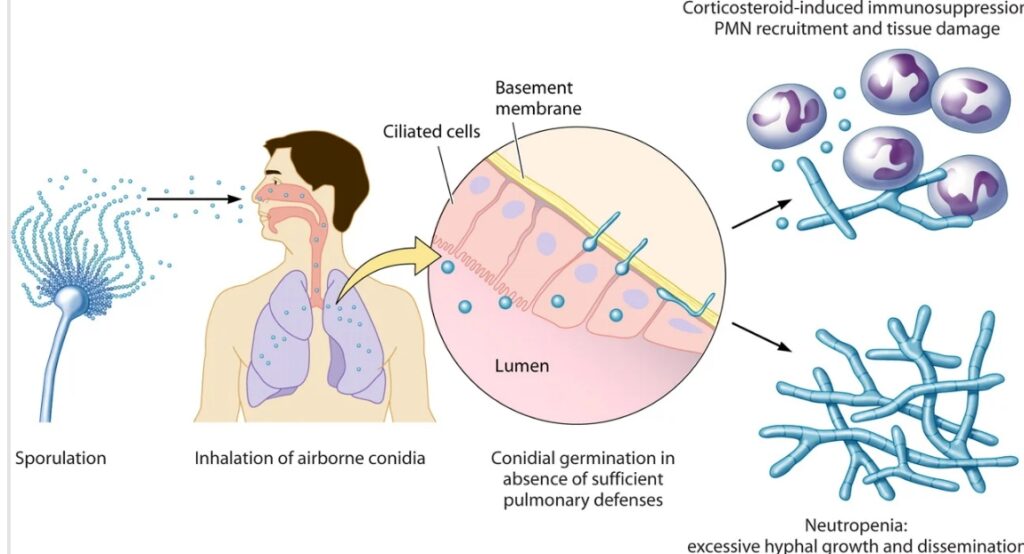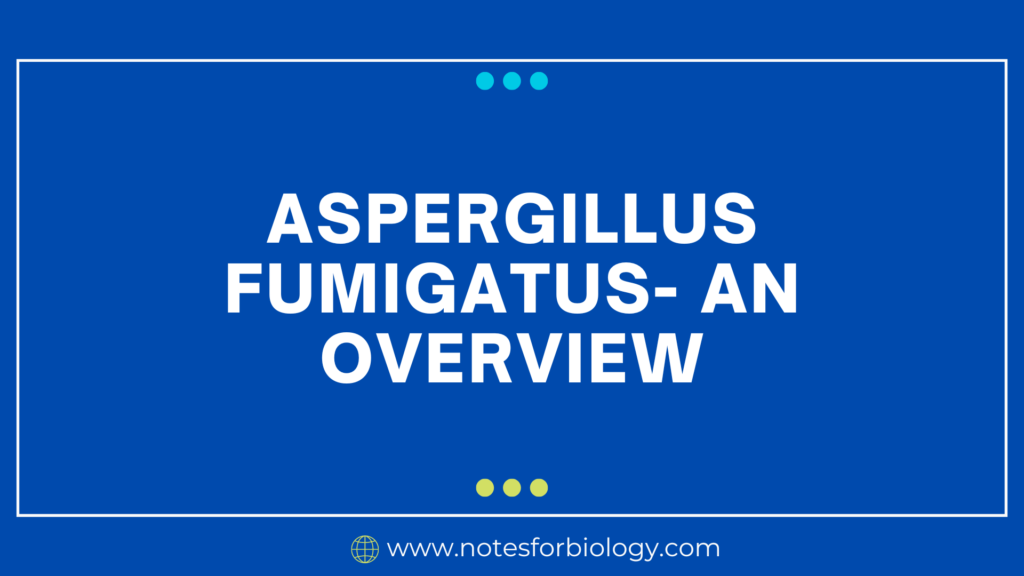Aspergillus is a common mold found in a variety of habitats, including soil, decomposing organic materials, and indoor air. It is one of the most widespread species in the Aspergillus genus, with a considerable impact on both natural ecosystems and human health. This analysis focuses on its properties, ecological importance, and consequences for human health.

Table of Contents
Characteristics of Aspergillus fumigatus
Conidial Heads
The conidial heads of Aspergillus are visually striking, often displaying a vibrant blue-green hue that sets them apart. These structures are comprised of a multitude of conidia (asexual spores) that are intricately produced on specialized stalks known as conidiophores.
Hyphae
The hyphae of fungi are characterized by septate, which means they are divided by cross-walls (septa) into individual cells. These hyphae form a dense, branching network known as mycelium. This mycelium spreads through the substrate, effectively absorbing nutrients from its surroundings.
Conidia
Conidia, which are small spherical spores measuring 2-3 micrometers in diameter, possess a high resistance to desiccation, allowing them to remain airborne for extended periods. As a result, they are capable of widespread dispersion through the widespread dispersion through the air.
Decomposition
It contributes significantly to the decomposition of organic materials. It secretes a variety of extracellular enzymes, including proteases, lipases, and cellulases, which degrade complex chemical molecules into simpler ones that may be ingested for nutrition.
Secondary Metabolites
The fungus creates several secondary metabolites, some of which are hazardous. While it does not create as many mycotoxins as Aspergillus flavus or Aspergillus parasiticus, it can produce chemicals like gliotoxin, which can inhibit the immune system and contribute to pathogenicity.
Thermotolerance
Its capacity to grow at high temperatures and live in conditions such as compost heaps demonstrates its thermotolerance, which is critical to its ecological survival.
Habitat of Aspergillus fumigatus
- Aspergillus is a fungus that thrives in soil and feeds on organic detritus.
- It is one of the most widespread airborne saprophytic fungi.
- It is mostly prevalent in the air, therefore people and animals are continuously inhaling conidia.
- It belongs to the Aspergillus group of fungi.
Morphology of Aspergillus fumigatus
1. Macroscopic Morphology
Colony Appearance
On agar plates, fumigatus colonies typically appear as velvety or powdery textures with a blue-green to gray-green color. The reverse side of the colony is usually white to yellowish.
Growth Pattern
The mold exhibits rapid growth, often filling the Petri dish within a few days under optimal conditions. The colonies can reach a diameter of 3 to 4 cm within 5 to 7 days at 37°C.
2. Microscopic Morphology
Conidial Heads
The conidial heads are compact, columnar, and uniseriate. They are typically blue-green, composed of tightly packed conidia that give them a powdery appearance.
Conidiophores
Conidiophores are the specialized stalks that bear the conidia. They are smooth, hyaline (translucent), and measure 200-300 micrometers in length. The conidiophores terminate in a vesicle at the tip, which is typically globose to subglobose in shape.
Taxonomy of Aspergillus fumigatus
| Order Eurotiales | |
| Kingdom Fungi | |
| Genus Aspergillus | |
| Division Ascomycota | |
| Domain Eukaryota | |
| Family Aspergillaceae | |
| Class Eurotiomycetes |
Life cycle of Aspergillus fumigatus
The life cycle of it is predominantly characterized by asexual reproduction through the production and dispersal of conidia. These conidia germinate to form mycelium, which grows and eventually produces new conidiophores, completing the cycle.
- Conidia: The life cycle normally starts with the dissemination of asexual spores known as conidia.
- Airborne Dissemination: Since conidia are tiny and lightweight, they may stay airborne for long periods and travel great distances.
- Environmental circumstances: Conidia germinate when they settle on a suitable substrate under favorable environmental circumstances.
- Germ Tube Formation: After germination, the conidium expands and a germ tube develops, which elongates to create the hypha.
- Mycelium Formation: The germ tube continues to expand and branch, resulting in a network of hyphae known as mycelium.
- Absorption: The mycelium enters the substrate and secretes enzymes that degrade complex organic molecules into simpler components, which are then absorbed as nutrients.
- Aerial Hyphae: Some hyphae grow upwards from the mycelium, forming specialized structures called conidiophores.
- Vesicle Formation: The tip of each conidiophore swells to form a vesicle, which serves as the site for conidium production.
Control and Management
Controlling Aspergillus fumigatus requires a mix of environmental, medicinal, and preventative measures. Environmental control focuses on limiting spore exposure through techniques such as employing HEPA filters in ventilation systems, keeping indoor humidity low using dehumidifiers, ensuring optimum ventilation, and cleaning surfaces regularly to eliminate dust and mold spores. Additionally, adopting mold-resistant materials and controlling dust during construction or restoration can help to reduce hazards. Infections are treated with antifungal drugs such as voriconazole, amphotericin B, and echinocandins, whereas allergic bronchopulmonary aspergillosis (ABPA) is managed with corticosteroids and itraconazole. Aspergillomas may require surgical removal in extreme situations. Prophylactic antifungal therapies are also indicated for high-risk individuals, such as those receiving chemotherapy or organ transplants.
Frequently Asked Question
Where is Aspergillus fumigatus commonly found?
It is ubiquitous in the environment. It thrives in soil, compost piles, decaying vegetation, and indoor air, especially in places with poor ventilation.
How does Aspergillus fumigatus reproduce?
Aspergillus primarily reproduces asexually through the production of conidia (asexual spores). These spores are dispersed into the air, where they can land on suitable substrates and germinate to form new fungal colonies.
What diseases are caused by Aspergillus fumigatus?
It can cause several diseases, especially in immunocompromised individuals:
Invasive Aspergillosis: A serious infection that can affect the lungs and other organs.
Allergic Bronchopulmonary Aspergillosis (ABPA): An allergic reaction in the lungs, common in individuals with asthma or cystic fibrosis.
Related Articles

